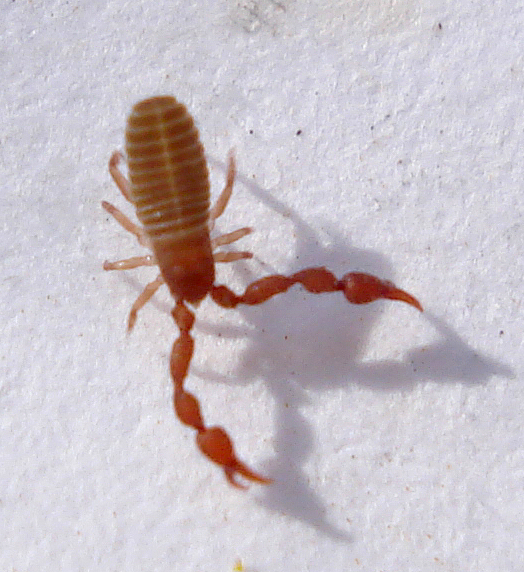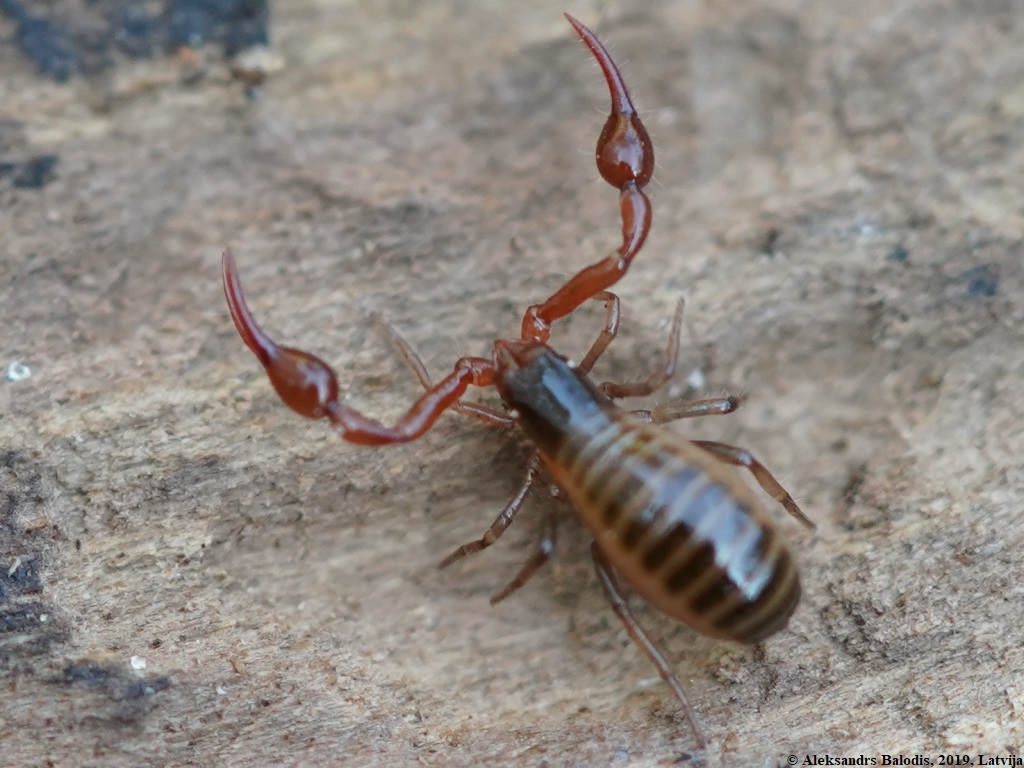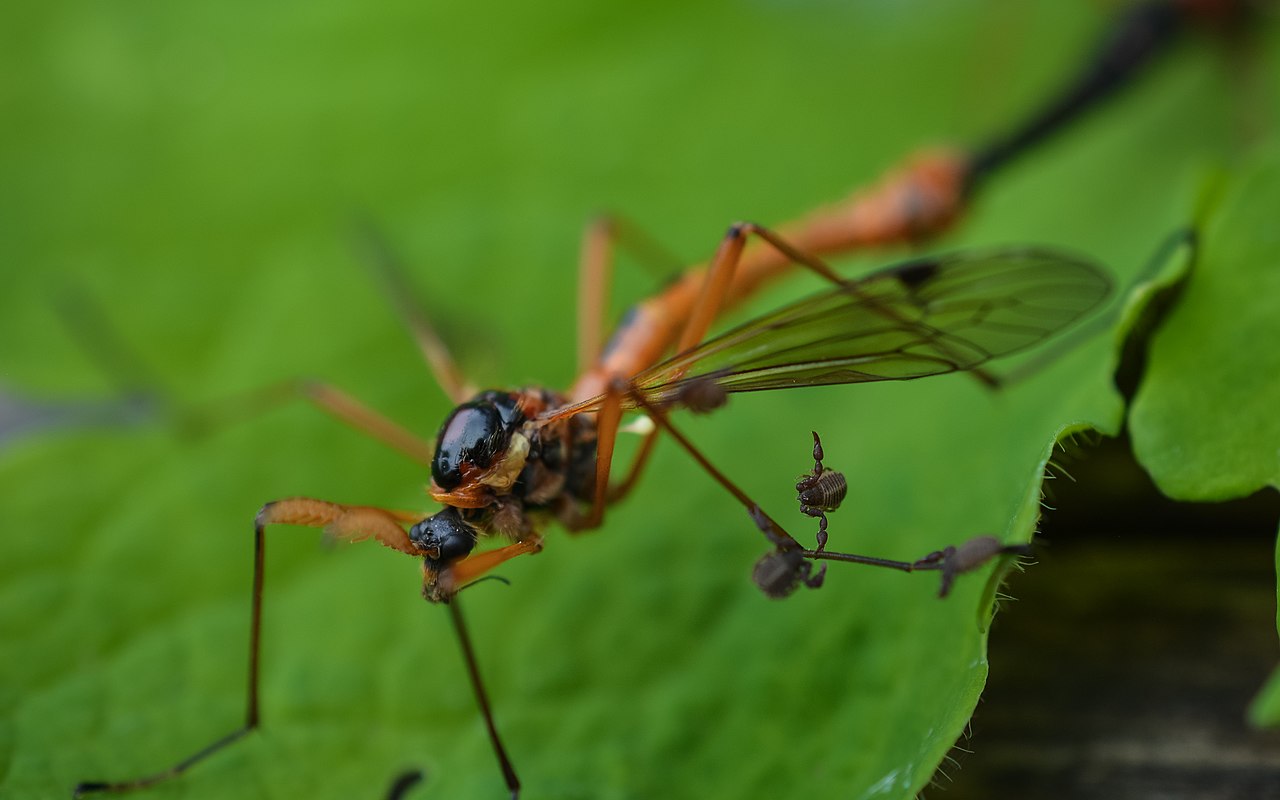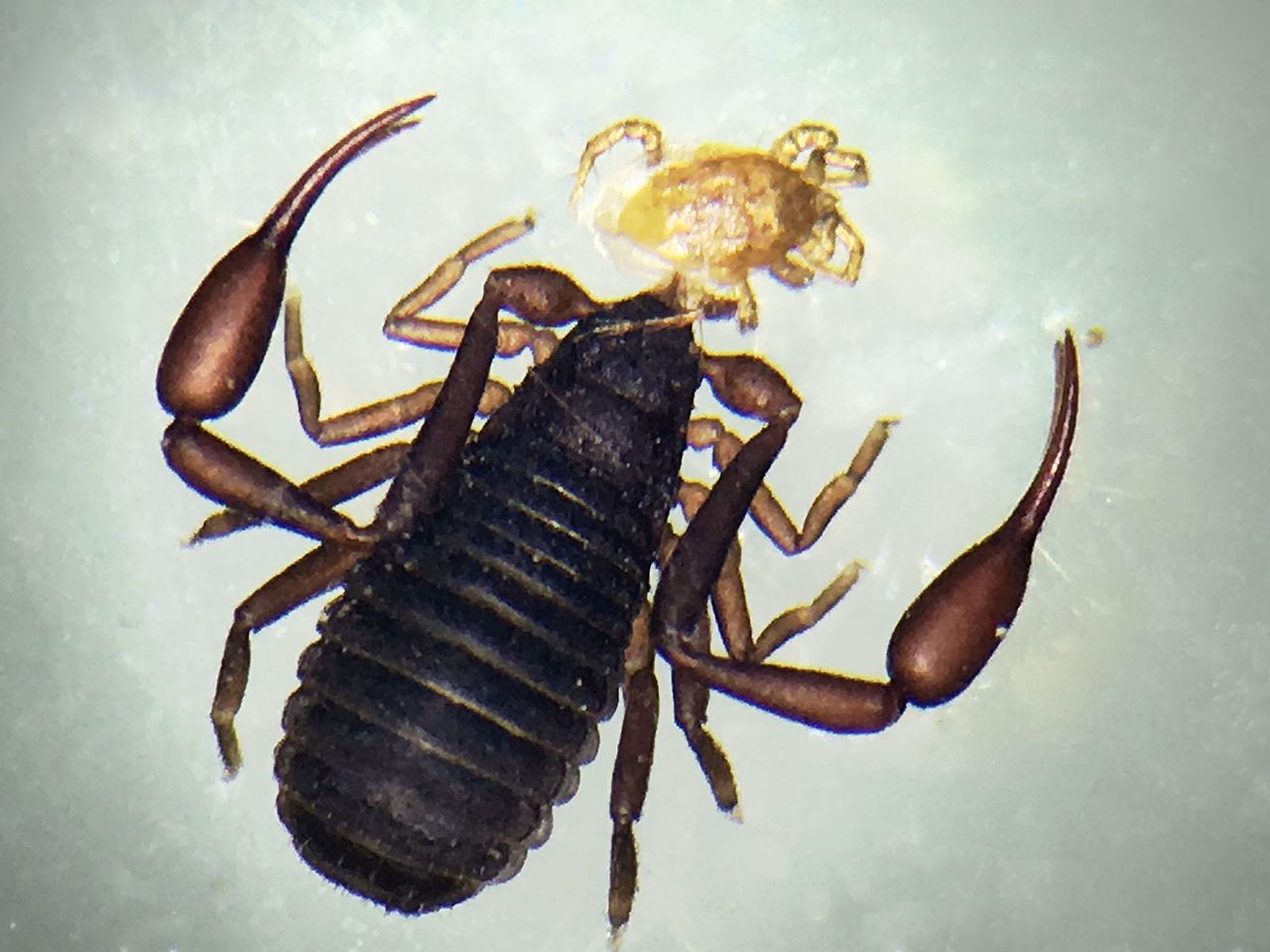- Home
- Garden Wildlife
- Arthropods
- Arachnids
- Pseudoscorpions
Pseudoscorpions
As the name suggests, pseudoscorpions or false scorpions are not real scorpions and they are entirely harmless. They belong to the order Pseudoscorpiones of the Class Arachnida. As with other arachnids, pseudoscorpions have four pairs of legs. They feed on small invertebrate animals and their mouthparts include a pair of chelicerae. These small animals superficially resemble scorpions with their large pincer-like pedipalps, but they lack a stinging tail and various other peculiarities of true scorpions.
Species in Britain and Ireland
Globally over 3,300 species have been described, with nearly 30 in Britain and Ireland. Jennifer Owen recorded one species in her garden compost heap. Some common and widespread species are Chthonius tetrachelatus, Chthonius ischnocheles, Neobisum carcinoides, Dinocheirus panzeri and Lamprochernes nodosus.
Pseudoscorpions: Lamprochernes nodosus Neobisium carcinoides
Biology
Pseudoscorpions found in Britain and Ireland are 2-5mm long when fully grown and are brown, black or creamy brown in colour. They are predators on even smaller insects and other animals, using their pedipalps to seize prey and inject them with venom. Digestive enzymes are then secreted into the prey and the liquified body contents are sucked up.
Another use for the pedipalps is to grip and hang on to a larger insect or bird and be carried to a new location. This means of dispersal is known as phoresy, or colloquially as hitch-hiking.



Most pseudoscorpions live in outdoor situations, such as in leaf litter, compost heaps, birds’ nests, under loose bark and in old thatched roofs. Cheiridium museorum and Chelifer cancroides live in houses and sheds where they feed on household invertebrates.

Life cycle
A male pseudoscorpion places his semen in a silk ball known as a spermatophore. This is placed near a female who will walk over and absorb the spermatophore into her genital opening. She retains her eggs in a pouch on the underside of her abdomen until after they have hatched.
Newly hatched pseudoscorpions are initially fed with fluids secreted in the maternal brood pouch. Young pseudoscorpions have a similar appearance to the adult animals. They shed their outer skin on several occasions as they increase in size. When they are ready to shed their skin they spin a protective silk enclosure around themselves.
Role of pseudoscorpions in gardens
Pseudoscorpions can be a sign of a healthy garden ecosystem. They are predatory animals that feed on a wide range of invertebrates. Although pseudoscorpions have poison-injecting pedipalps, they are quite incapable of causing any injury to people.
Other sources of information
Website
Website of the Pseudoscorpion Recording Scheme
Web site of the British Arachnological Society
Natural History Museum checklist of pseudoscorpions
Books
Legg, G. (1988) Synopses of the British Fauna, vol. 40, Pseudoscorpions. Linnean Society
Page text drafted by Andrew Halstead, reviewed by Andrew Salisbury, compiled by Steve Head
Pseudoscorpion Chelifer cancroides eating a predatory mite which it has caught.
Four pseudoscorpions hitch-hiking on the leg of a crane fly.
Pseudoscorpions
As the name suggests, pseudoscorpions or false scorpions are not real scorpions and they are entirely harmless. They belong to the order Pseudoscorpiones of the Class Arachnida. As with other arachnids, pseudoscorpions have four pairs of legs. They feed on small invertebrate animals and their mouthparts include a pair of chelicerae. These small animals superficially resemble scorpions with their large pincer-like pedipalps, but they lack a stinging tail and various other peculiarities of true scorpions.
Species in Britain and Ireland
Globally over 3,300 species have been described, with nearly 30 in Britain and Ireland. Jennifer Owen recorded one species in her garden compost heap. Some common and widespread species are Chthonius tetrachelatus, Chthonius ischnocheles, Neobisum carcinoides, Dinocheirus panzeri and Lamprochernes nodosus.
Pseudoscorpions
As the name suggests, pseudoscorpions or false scorpions are not real scorpions and they are entirely harmless. They belong to the order Pseudoscorpiones of the Class Arachnida. As with other arachnids, pseudoscorpions have four pairs of legs. They feed on small invertebrate animals and their mouthparts include a pair of chelicerae. These small animals superficially resemble scorpions with their large pincer-like pedipalps, but they lack a stinging tail and various other peculiarities of true scorpions.
Species in Britain and Ireland
Globally over 3,300 species have been described, with nearly 30 in Britain and Ireland. Jennifer Owen recorded one species in her garden compost heap. Some common and widespread species are Chthonius tetrachelatus, Chthonius ischnocheles, Neobisum carcinoides, Dinocheirus panzeri and Lamprochernes nodosus.
Pseudoscorpions
As the name suggests, pseudoscorpions or false scorpions are not real scorpions and they are entirely harmless. They belong to the order Pseudoscorpiones of the Class Arachnida. As with other arachnids, pseudoscorpions have four pairs of legs. They feed on small invertebrate animals and their mouthparts include a pair of chelicerae. These small animals superficially resemble scorpions with their large pincer-like pedipalps, but they lack a stinging tail and various other peculiarities of true scorpions.
Species in Britain and Ireland
Globally over 3,300 species have been described, with nearly 30 in Britain and Ireland. Jennifer Owen recorded one species in her garden compost heap. Some common and widespread species are Chthonius tetrachelatus, Chthonius ischnocheles, Neobisum carcinoides, Dinocheirus panzeri and Lamprochernes nodosus.
Pseudoscorpions: Lamprochernes nodosus Neobisium carcinoides
Biology
Pseudoscorpions found in Britain and Ireland are 2-5mm long when fully grown and are brown, black or creamy brown in colour. They are predators on even smaller insects and other animals, using their pedipalps to seize prey and inject them with venom. Digestive enzymes are then secreted into the prey and the liquified body contents are sucked up.
Another use for the pedipalps is to grip and hang on to a larger insect or bird and be carried to a new location. This means of dispersal is known as phoresy, or colloquially as hitch-hiking.

Most pseudoscorpions live in outdoor situations, such as in leaf litter, compost heaps, birds’ nests, under loose bark and in old thatched roofs. Cheiridium museorum and Chelifer cancroides live in houses and sheds where they feed on household invertebrates.
Pseudoscorpion Chelifer cancroides eating a predatory mite which it has caught.

Life cycle
A male pseudoscorpion places his semen in a silk ball known as a spermatophore. This is placed near a female who will walk over and absorb the spermatophore into her genital opening. She retains her eggs in a pouch on the underside of her abdomen until after they have hatched.
Newly hatched pseudoscorpions are initially fed with fluids secreted in the maternal brood pouch. Young pseudoscorpions have a similar appearance to the adult animals. They shed their outer skin on several occasions as they increase in size. When they are ready to shed their skin they spin a protective silk enclosure around themselves.
Role of pseudoscorpions in gardens
Pseudoscorpions can be a sign of a healthy garden ecosystem. They are predatory animals that feed on a wide range of invertebrates. Although pseudoscorpions have poison-injecting pedipalps, they are quite incapable of causing any injury to people.
Other sources of information
Website
Website of the Pseudoscorpion Recording Scheme
Web site of the British Arachnological Society
Books
Legg, G. (1988) Synopses of the British Fauna, vol. 40, Pseudoscorpions. Linnean Society
Page text drafted by Andrew Halstead, reviewed by Andrew Salisbury, compiled by Steve Head












